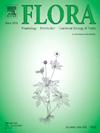Predicting the suitable habitat distribution of Polygonatum kingianum under current and future climate scenarios in southwestern Yunnan, China
IF 1.7
4区 生物学
Q3 ECOLOGY
引用次数: 0
Abstract
Climate change affects the distribution patterns and chemical composition of medicinal plants, leading to quality differences. Polygonatum kingianum Collett & Hemsl. (P. kingianum) is a Chinese medicine and food homolog. With the increasing market demand, the sustainable supply and quality assurance of P. kingianum are particularly important. This study used the maximum entropy (MaxEnt) model to predict the potential habitat suitability under current and future (2050s and 2070s) climate change scenarios, including Shared Socioeconomic Pathways (SSP) 245 and 585. In addition, chemical information of P. kingianum from different geographical sources was collected based on fourier transform near infrared spectroscopy (FT-NIR), and the geographical origin of P. kingianum was identified using a combination of two-dimensional correlation spectroscopy (2DCOS) and residual convolutional neural network (ResNet) to evaluate the impact of different geographical sources on the quality of P. kingianum. We explored the correlation between absorbance and environmental factors from the perspective of spectral information. The research results indicated that annual mean temperature (Bio01), temperature seasonality (Bio04), annual precipitation (Bio12), precipitation of driest month (Bio14) and elevation (Ele) are the main environmental factors affecting the distribution of P. kingianum. In the current climate scenario, the suitable habitat was mainly located the southwest of China, including Yunnan, Sichuan, Guizhou and Chongqing. The area of lowly (0.2 ≤ suitability indices < 0.4) suitable habitat was 57.20 × 104 km2, accounting for 51 % of the total suitable habitat area. The total land area comprising potential suitable habitat is predicted to expand under future climate scenarios. Under the emission scenario 245 (SSP245), the change rate of highly suitable habitat in 2070 was 30.26 %. The combination of 2DCOS and ResNet model successfully identified samples of P. kingianum from different geographical sources, with an accuracy rate of 100 %. In summary, the research results provided a fast and accurate method for the geographical tracing of P. kingianum, and provided theoretical guidance for the protection and sustainable utilization of wild resources.

求助全文
约1分钟内获得全文
求助全文
来源期刊

Flora
生物-植物科学
CiteScore
3.30
自引率
10.50%
发文量
130
审稿时长
54 days
期刊介绍:
FLORA publishes original contributions and review articles on plant structure (morphology and anatomy), plant distribution (incl. phylogeography) and plant functional ecology (ecophysiology, population ecology and population genetics, organismic interactions, community ecology, ecosystem ecology). Manuscripts (both original and review articles) on a single topic can be compiled in Special Issues, for which suggestions are welcome.
FLORA, the scientific botanical journal with the longest uninterrupted publication sequence (since 1818), considers manuscripts in the above areas which appeal a broad scientific and international readership. Manuscripts focused on floristics and vegetation science will only be considered if they exceed the pure descriptive approach and have relevance for interpreting plant morphology, distribution or ecology. Manuscripts whose content is restricted to purely systematic and nomenclature matters, to geobotanical aspects of only local interest, to pure applications in agri-, horti- or silviculture and pharmacology, and experimental studies dealing exclusively with investigations at the cellular and subcellular level will not be accepted. Manuscripts dealing with comparative and evolutionary aspects of morphology, anatomy and development are welcome.
 求助内容:
求助内容: 应助结果提醒方式:
应助结果提醒方式:


